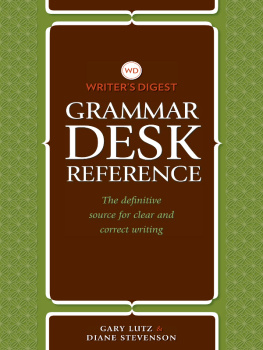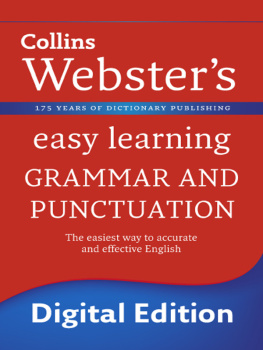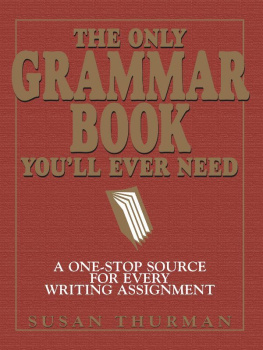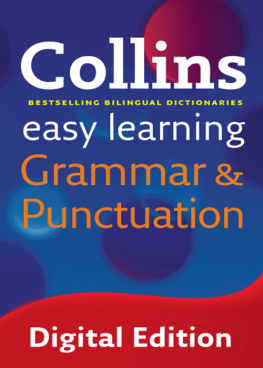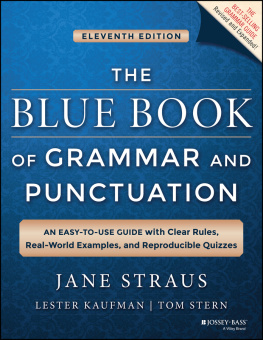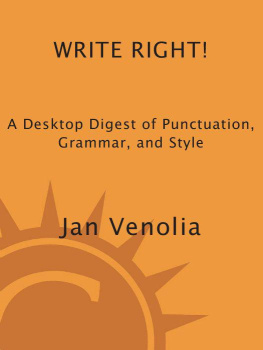

WRITER'S DIGEST
GRAMMAR
DESK
REFERENCE
The definitive
source for clear and
correct writing

WRIERS DIGEST
BOOKS
WritersDigest.com
Cincinnati, Ohio
GARY LUTZ &
DIANE STEVENSON
Writer's Digest Grammar Desk Reference. Copyright 2010 by Gary Lutz & Diane Stevenson. All rights reserved. No other part of this book may be reproduced in any form or by any electronic or mechanical means including information storage and retrieval systems without permission in writing from the publisher, except by a reviewer, who may quote brief passages in a review. Published by Writers Digest Books, an imprint of F+W Media, Inc., 4700 East Galbraith Road, Cincinnati, Ohio 45236. (800) 289-0963.
For more resources for writers, visit www.writersdigest.com/books.
To receive a free weekly e-mail newsletter delivering tips and updates about writing and about Writers Digest products, register directly at http://newsletters.fwpublications.com.
The Library of Congress has catalogued the hardcover edition as follows:
Library of Congress Cataloging-in-Publication Data
Lutz, Gary
The Writers Digest grammar desk reference : the definitive source for clear and correct writing / Gary Lutz & Diane Stevenson.
p. cm.
ISBN 1-58297-335-0 (alk. paper)
1. English languageGrammarHandbooks, manuals, etc. 2. English languageRhetoricHandbooks, manuals, etc. 3. English languageUsageHandbooks, manuals, etc. I. Stevenson, Diane II. Title.
PE1112.L88 2005
428.2dc22
2004063750
ISBN-13 978-1-59963-220-9 (pbk:alk.paper)
ISBN-10 1-59963-220-9 (pbk:alk.paper)
eISBN: 978-1-5996-3220-9
This e-book edition: October 2011 (v.1.0)

Edited by: Kelly Nickell and Melissa Wuske
Designed by: Claudean Wheeler, based on the first edition design by Lisa Kuhn
Production coordinated by: Debbie Thomas
ABOUT THE AUTHORS

Gary Lutz is the author of the short-story collections Stories in the Worst Way (published in hardcover by Alfred A. Knopf in 1996 and in paperback by 3rd bed in 2002) and I Looked Alive (published by Black Square Editions/Four Walls Eight Windows in 2004). His chapbook, Partial List of People to Bleach, was released by Future Tense Books in 2007. His work has appeared in several anthologies, including The Random House Treasury of Light Verse and The Anchor Book of New American Short Stories. He has been awarded grants from the National Endowment for the Arts and the Foundation for Contemporary Performance Arts.
Diane Stevenson is the editor of two collections of newspaper columns by best-selling novelist Carl Hiaasen, Kick Ass: Selected Columns of Carl Hiaasen and Paradise Screwed: Selected Columns of Carl Hiaasen. She has been the recipient of grants from the Ohio Arts Council and the Florida Humanities Council. Her work has appeared in Poetry, The American Poetry Review, and elsewhere. She teaches at the University of Florida.
Table of Contents
INTRODUCTION
Books about grammar tend to fall into two categories. In the first category are books that describe the operations of the English language and explain how words go about performing their uncanny business in sentences. The approach of such books, unfortunately, is often far removed from the workaday urgency with which we fit words together into sentences and get our hands dirty in the entanglements of syntax and usage. In the second category are books that present a set of rules enabling writers to avoid conspicuous or subtle errors. Such books are practical, but they often leave readers yearning for a larger, clarifying context or reasons why a particular construction is deemed correct or not.
Our book attempts to integrate the two approaches by providing both a macrogrammar and a microgrammarfirst, a systematizing of the often perplexing behaviors of words and, second, a how-to guide that will help you produce sentences free of the kinds of errors that distract readers.
Some readers might think that the formulation of rules is an arbitrary or elitist act. The rules and principles set forth in this book, however, are not decrees issued from on high. Instead, the conventions we present here have been induced from a very close inspection of how professional writers and the editorial departments of distinguished newspapers, magazines, and book publishers handle the intricate and sometimes vexatious matters of grammar, punctuation, mechanics, and usage. Such wordsmiths deserve our emulation. They err so rarely that their errors are unusually instructive.
Rather than invent our own sentences to illustrate what can go wrong on the page, therefore, we have extracted erroneous sentences from lively published sources, mostly newspapers and magazines we enjoy reading. (You are likely to notice that some of the illustrative sentences are weakened by more than one kind of error.) The sentences are included to demonstrate that even the most gifted writers can bend or even break the rules of grammar, punctuation, and usage, especially when a deadline looms and the pressure is intense. The errors sometimes slip past even the most vigilant and conscientious editors, copy editors, and proofreaders.
That our very best writers now and then commit errors should deepen our appreciation of just how demanding the craft of writing isfrom drafting, composing, and revising to editing, proofreading, and printing. We are certain that, despite diligent proofreading, we ourselves are likely to have committed our share of blunders in the production of this book. We therefore invite readers to alert us to our lapses. (Diane Stevenson wrote Part I; Gary Lutz wrote Parts IIIV.) You can e-mail Diane at part1grammar@yahoo.com and Gary at gram mardeskref@aol.com.
Throughout the book, we emphasize the importance of having a good dictionary close by as you write. The desk dictionaries that we recommend (each includes about 160,000 words) are Websters New World College Dictionary and Merriam-Websters Collegiate Dictionary. The unabridged dictionary that we recommend is Websters Third New International Dictionary (published by Merriam-Webster).
For those of you who become interested in reading further about grammar, punctuation, mechanics, and usage, we recommend ten thorough, revered, authoritative, and altogether extraordinary books that shaped our own sensibilities: Garners Modern American Usage, by Bryan A. Garner (Oxford University Press, 2003); Modern American Usage: A Guide, by Wilson Follett and revised by Erik Wensberg (Hill and Wang, 1998); The Careful Writer, by Theodore M. Bernstein (Free Press, 1995); The Handbook of Good English, by Edward D. Johnson (Washington Square Press, 1991); Understanding Grammar, by Paul Roberts (Harper, 1954); Rhetorical Grammar: Grammatical Choices, Rhetorical Effects, third edition, by Martha Kolln (Allyn and Bacon, 1998); Right Words, Right Places
Next page
